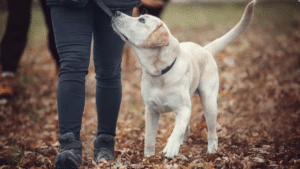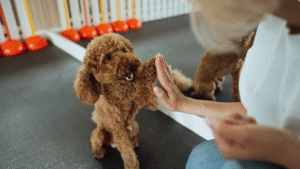Dog training is one of the most rewarding aspects of pet ownership — and also one of the most frustrating when things aren’t going as well as you’d like. Whether you’ve just brought home a new puppy or are working with a rescued adult dog, the foundations of good behavior, safety, and communication all begin with training.
The problem is, many dog owners make basic training mistakes without even realizing it. These common errors can not only make training take longer and feel more frustrating, but they can also lead to bad habits and even behavioral problems down the line.
The good news is that once you know what you’re doing wrong, you can quickly correct course and set your dog up for success.

Mistakes You’re Making During Basic Dog Training
1. You’re Inconsistent With Commands and Rules
Inconsistency may be the number one training pitfall for many dog owners. Dogs thrive on structure, routine, and clear communication. They might not remember the word you used for “come here” one day if you change it to something else the next. When rules and expectations aren’t consistent, your dog becomes confused.
For example, if your dog is allowed to jump all over you when you’re wearing jeans but is scolded for jumping when you’re dressed up, they won’t understand the difference. All they know is that sometimes it’s allowed — so they’ll keep testing the boundaries.
The fix:
-
Choose consistent verbal cues. Make sure everyone in your household uses the same words for each command. Pick a single word for “sit,” “stay,” “down,” “come,” and other basics.
-
Keep rules consistent. If your dog isn’t allowed on the furniture, that rule should always apply. Avoid exceptions or “just this once” situations — mixed signals will only slow down your progress.
-
Establish a daily routine. Dogs learn best when their days are predictable — when they know what to expect. Build a schedule that includes feeding, potty breaks, walks, and training sessions.
Consistency builds trust, and trust makes training smoother and more successful.
2. Your Training Sessions Are Too Long or Too Short
It’s hard to train a dog effectively if they don’t understand what you want — and their attention span plays a big role in that. Puppies and younger dogs, in particular, have short windows of focus. If your training sessions are too long, they’ll lose interest and tune out.
On the other hand, if you only train for a few seconds at a time, your dog won’t get enough repetition to learn properly. Long, exhausting sessions can lead to frustration, loss of focus, and resentment for both you and your dog.
The fix:
-
Keep sessions short but frequent. For beginner training, limit each session to 5–10 minutes, two or three times a day.
-
End on a positive note. Finish when your dog does something right. Reward them with praise, treats, and affection. Ending on success builds enthusiasm for the next session.
-
Train throughout the day. Training doesn’t have to happen only during “training time.” Incorporate commands naturally — before meals, walks, or playtime.
By keeping sessions short, positive, and consistent, you’ll see faster progress and a happier, more focused dog.

3. You Rely Too Heavily on Punishment
Many dog owners fall into the trap of using too much punishment and not enough reward. Overcorrecting bad behavior without reinforcing good behavior can make your dog anxious, fearful, or hesitant to try new things.
Dogs don’t naturally associate punishment with specific actions the way humans do. If you yell at your dog or rub their nose in an accident, they don’t learn that the behavior was wrong — they just learn to fear you or to hide their mistakes.
The fix:
-
Use positive reinforcement training. Reward your dog immediately when they do something right — with treats, praise, or play. Dogs repeat behaviors that bring rewards.
-
Redirect unwanted behavior. Instead of punishing your dog, show them what you want them to do instead. For example, if they chew on a shoe, calmly replace it with a toy.
-
Avoid harsh corrections. Never hit, yell at, or scare your dog. Avoid intimidation-based tools like shock collars unless guided by a qualified professional trainer.
Positive reinforcement isn’t just kinder — it’s scientifically proven to be more effective and longer-lasting than punishment-based methods.
4. You Aren’t Doing Enough Socialization
Socialization is a critical part of training that owners often overlook, especially during the puppy phase. Well-socialized dogs are confident, calm, and adaptable around new people, places, and situations. Poorly socialized dogs are often fearful, anxious, or even aggressive in unfamiliar environments.
Socialization doesn’t just mean meeting other dogs (though that’s part of it). It involves exposing your dog to a wide range of experiences — different sights, sounds, textures, and situations. This could include car rides, walking on various surfaces, hearing vacuum cleaners, or meeting people wearing hats or uniforms.
The fix:
-
Start early. The ideal socialization window for puppies is between 3 and 14 weeks of age, but older dogs can still benefit from careful, patient exposure.
-
Pair rewards with new experiences. When your dog encounters something new and stays calm, reward them with praise or treats.
-
Be patient and gradual. Never force your dog into a situation that feels overwhelming. Build confidence step by step — not fear.
A well-socialized dog is easier to train, less reactive, and happier overall. Think of socialization as an investment in your dog’s long-term emotional health.
5. You Have Unrealistic Expectations
Dog training is a marathon, not a sprint. Many owners, especially in today’s fast-paced world, expect results overnight. When progress feels slow, frustration builds — and that can lead to giving up too soon or moving on before your dog truly understands a skill.
Training speed varies widely depending on breed, age, temperament, and past experiences. A rescue dog who’s had little structure may need more time and reassurance than a puppy raised in a stable home.
The fix:
-
Be patient and consistent. Repetition is key. Remember, your dog doesn’t speak your language — they learn through repetition and routine. Stick with it and stay consistent.
-
Reward progress, not perfection. Even small improvements deserve praise. If your dog is trying, they’re learning.
-
Stay calm and positive. Dogs are sensitive to your emotions. If you’re frustrated or impatient, your dog will pick up on it and lose confidence.
Dog training is about steady progress, not instant perfection. Each small success builds toward long-term results.

Bonus: You’re Not Tailoring Training to Your Dog’s Personality
While the five mistakes above are the most common, there’s another crucial factor that can make or break your success — understanding your dog’s individual personality.
No two dogs are the same. A high-energy Border Collie might need fast-paced, mentally stimulating exercises, while a relaxed Bulldog might prefer slower, calmer sessions. Some dogs are motivated by food, others by toys or praise. Recognizing and adapting to your dog’s unique temperament can make training much more effective.
How to adjust your training:
-
Discover what motivates your dog. Whether it’s food, toys, or affection, use their favorite reward to reinforce good behavior.
-
Match your energy level to your dog’s. A calm trainer helps balance an excitable dog, while an enthusiastic tone can encourage a shy or hesitant dog.
-
Be flexible. If one training method isn’t working, try another. Training isn’t one-size-fits-all — it’s about finding what works for your individual dog.
Adapting your approach to your dog’s personality builds trust, improves communication, and accelerates progress.

The Takeaway
Dog training isn’t just about teaching commands — it’s about communication, respect, and building a lifelong bond. Mistakes are normal, especially for new dog owners, but most are easy to fix once you recognize them.
Be consistent with commands and rules, keep training sessions short and positive, focus on positive reinforcement, make time for socialization, and most importantly, be patient.
Above all, enjoy the process. Dog training is not only about shaping your dog’s behavior — it’s about deepening your relationship and creating a partnership based on trust and understanding.
- 5 Cheap Alternatives To Dog Training Equipment - November 12, 2025
- Homemade Calming Spray To Help Dogs During Training - November 12, 2025
- 7 DIY Dog Training Tools You Can Make From Household Items - November 12, 2025
